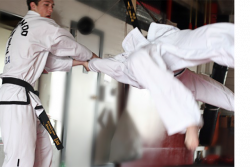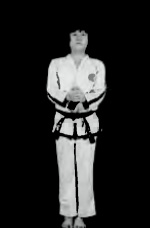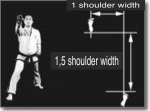Student Booklet - 3rd KUP exam (Blue belt / Red tag)
Student booklet /
Main Menu
Student Booklet - 3rd KUP exam (Blue belt / Red tag)
Exam 3rd Kup
Student booklet
Select the level of the exam or the full booklet in the following box to have the theory you require :
Joong-Gun Historical background (TAEKWONDO YOKSA) for 3rd KUP exam
"JOONG-GUN" is named in reference to the patriot AHN JOONG-GUN who murdered Hiro Bumi Ito (the (the first Japanese governor-general of Korea).
The 32 movements of the Tul represents the age of Ahn when he was executed in Lui-Shung prison (1910).
End: Bring the left foot to MOA SOGI B
Back to top of page - Back to Welcome Page
Knowledge of Taekwondo for 3rd KUP
Matsogi
For the exam, the student must perform 10 SAMBO MATSOGI programs. In addition, the student's needs 10 IBO MATSOGI (two-step) demonstration. During the exam, the student will also perform 8-ILBO MATSOGI's (one step sparing).
Should you need a reminder on how to proceed, see this link.
Hosinsul
Foreword
In HOSINSUL (self-defense), there usually is a physical contact between the attacker to defender.
In defense against weapons there usually is a physical contact of the defender against the attacker.
We divide hosinsul into two parts:
- Physical contact attacker
- Forward with weapons
Therefore, ITF Taekwondo is a modern sport considering all possible defense techniques such as long distance (legs), medium range (arms, elbow, knee) or close combat (throwing, extrication, vital points).
Note: It is always possible that one is faced with a very strong opponent. Here are two solutions:
- Use your speed and a rotational movement.
- Hit the opponent on a painful place.
Physical contact attacker
The opponent holds.
Three possibilities:
- Offensive movement: attacks with stroke or stamp on a vital place or vulnerable body spot.
- Breaking movement: on the attacking limb.
- Liberation movement: a twisting motion followed by counterattack.
Attack Situations
- standing
- kneeling
- lying
- sudden attack of opponent
Back to top of page - Back to Welcome Page
Throwing and falling techniques
Falling is an art, take into account these rules :
- Relax Body
- Try to fall on your side, not your front or back.
- Safely absorb the shock with the palm of the hand on the ground.
- avoid hitting the head.
- Legs high.
Don’t just throw your opponent to the ground during training, you do not want to hurt him.
Ground Principle: make opponent off balance. Possibilities:
- Standing
- Kneeling
- Lying
Attacker with weapons
You are attacked with a weapon (s). Dodging is the most appropriate move, but you're not safe enough.
Try to let the opponent make an additional "step". To be so close to him (or to the weapon according to your placement) makes it easier to finish your counterattack.
Pihagi (= evade, avoid) is important. Left or right, but not back in line. Block against the arm or hand, but not against the weapon (don’t touch the weapon when blocking, especially when blocking knives).
Back to top of page - Back to Welcome Page
Hand-Technique for 3rd KUP
| Korean | English |
|---|---|
| SONKAL DUNG KAUNDE BAKURO MAKGI | Reverse knife-hand middle reverse block |
| SONDABAK BANDAE OLLYO MAKGI | Palm upward block |
| WI PALKUP TAERIGI | Upper elbow strike |
| SANG JOOMUK NOPUNDE SEWO JIRUGI | Twin fist high vertical punch |
| SANG JOOMUK DWIJIBO JIRUGI | Twin fist upset punch |
| KYOCHA JOOMUK CHOOKYO MAKGI | X-fist rising block |
| DOO PALMOK NOPUNDE MAKGI | Double forearm block |
| SONDABAK BANDAE NOOLLO MAKGI | Palm pressing block |
| KYOCHA JIRUGI | Front forefist angle punch |
| DIGUTJA MAKGI | U-shape block |
Back to top of page - Back to Welcome Page
DWITBAL SOGI - Rear Foot Stance
This mode is mainly used for defense, but sometimes also for the attack.
The great advantage of this mode is that it can be passed to attacks with a kick without displacement of the body weight. The position is always performed with a side facing.
Make sure the knee of the back leg is pointing inwards.
- Move either foot forward or backward, so that a distance of one shoulder width arises between the two toes.
- Bend the back leg so far as the knee is over the toes. Place the bck heel just behind the heel of the front foot.
- Bend the front leg and keep light contact with the ball of the foot of the front leg.
- M Make sure the toes of the front foot are facing about 25 degrees inward and the toes of the back foot are facing approximately 15 degrees inward.
- The body weight is primarily on the back leg.
- Move either foot forward or backward, so that a distance of one shoulder width arises between the two toes.
Back to top of page - Back to Welcome Page
MOA SOGI B - Closed Stance
A position held with the feet down together. Possibly executable with full facing or a side facing.
Some of the 24 patterns, starting with this position.
Back to top of page - Back to Welcome Page
NACHUO SOGI - Low stance
The advantage of this stance is the ease with which one can extend the attacking tool.
It can also develop the leg muscles and is effective to adjust the distance to and from the target.
It is similar to the walking stance, though longer by one foot. It can be either full facing or side facing.
Back to top of page - Back to Welcome Page
Grading to the 3rd Kup (Blue Belt - Red Tag)
- All the previous knowledge that you had to learn.
- Meaning of "Joong-Gun"
- New techniques to know, being able to show and explain
- Types of sine wave motions, being able to enumerate and explain
- Correctly perform "Chon-Ji" tul
- Correctly perform "Dan-Gun" tul
- Correctly perform "Do-San" tul
- Correctly perform "Won-Hyo" tul
- Correctly perform "Yul-Gok" tul
- Correctly perform 12 different Sambo Matsugi's (three step sparring)
- Correctly perform 10 different Ibo Matsugi's (two step sparring)
- Correctly perform 8 different Ilbo Matsugi's (one step sparring)
- 2 min fight with a partner for the purpose to demonstrate different learned techniques during a fight
- 10 practical hosinsul techniques to perform with partner
- Break test : 2 breaking techniques performing on wooden shelf of reusable shelf
- YOP CHAGI
- SONKAL DUNG TAERIGI
Back to top of page - Back to Welcome Page



